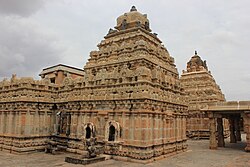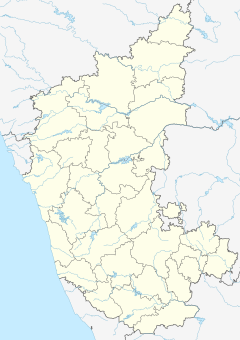Bhoga Nandeeshwara Temple
| Bhoga Nandeeshwara Temple complex | |
|---|---|

Bhoga Nandeeshwara Temple
|
|
| Location | Nandi, Karnataka, India |
| Coordinates | 13°23′12″N 77°41′53″E / 13.3868°N 77.6980°ECoordinates: 13°23′12″N 77°41′53″E / 13.3868°N 77.6980°E |
| Built | Early 9th century A.D.-16th century |
Bhoga Nandeeshwara Temple (also spelt "Bhoga Nandishwara" or "Bhoga Nandishvara") is a Hindu temple located in Nandi village, at the base of Nandi Hills (or Nandidurga) in the Chikkaballapur district of Karnataka state, India. It is dedicated to the Hindu god Shiva.
The original temple in the complex, identified as one of the oldest temples of Karnataka, dates back to the early 9th century. The earliest inscriptions referring to the construction of the temple for Shiva, according to the Archaeological Survey of India, are from Nolamba dynasty ruler Nolambadiraja and the Rashtrakuta emperor Govinda III dated c.806, and copper plates of the Bana rulers Jayateja and Dattiya of about c.810. The temple was later under the patronage of successive notable South Indian dynasties: the Ganga Dynasty, the Chola dynasty, the Hoysala Empire and the Vijayanagara Empire. In the post medieval era, the local chiefs of Chikaballapura and the rulers of the Mysore Kingdom (Hyder Ali and Tipu Sultan) controlled the region before it eventually came under British rule after the death of Tipu Sultan in c.1799. The architectural style is Dravidian. The temple is located at a distance of 60 km from Bangalore. The temple is protected as a monument of national importance by the Archaeological Survey of India.
The temple complex has two large shrines: the "Arunachaleswara" shrine to the south built by the Gangas of Talakad, and the "Bhoga Nandeeshwara" shrine to the north built by the Cholas. It has the sculpture of a king considered to be that of Rajendra Chola. In between there is a small intervening shrine called with "Uma-Maheshwara" shrine with a kalyana mantapa ("marriage alter") supported by ornate pillars in black stone with reliefs depicting of the Hindu gods Shiva and his consort Parvati, Brahma (the creator) and Saraswathi, Vishnu (the preserver) and his consort Lakshmi, the god of fire Agni and his consort Swaha Devi, and decorative creepers and birds in bas-relief. This is typical to Hoysala architecture.
...
Wikipedia

